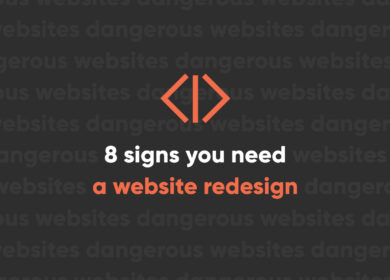
5 Reasons Website Redesigns Fail

In the online world of business, there’s almost nothing more exciting than launching a brand new website. The expectations are often high, especially after the months of work and preparation. Whether your website is eCommerce or lead generation, you’re confident a brand new site is just the ticket for instant business success.
Oftentimes, the new website turns out great. You get awesome feedback from your customers, your conversion rate skyrockets, and you get overwhelmed with leads and sales. Unfortunately, this isn’t always the case. Many business owners are baffled when their new website launches and they see their leads, sales, and web traffic plummet. How could this possibly happen with a slick new website that cost thousands of dollars?
This type of redesign fatigue is a surprisingly common occurrence, but it doesn’t have to happen to you. Here are 5 of the most common reasons why website redesigns fail.
1. You ditched the wrong content
During the process of your redesign, you probably streamlined some of your content. You may have opted to remove some thin or duplicate pages in favor of some beefier content. Or maybe you shut down the blog or removed some old videos or images. Or maybe you pulled some pages that just didn’t seem to fit with the new navigation or layout. But what if you ended up ditching some of the content that was actually driving people to your site or giving you a boost in the search results? Before getting rid of anything, you need to conduct a complete content audit to determine what’s working and what you can live without. Don’t assume any content is worthless without the data to prove it.
2. You don’t have KPIs or CTAs
Ah, those acronyms. They sound like buzzwords, but they are the bread and butter (pardon the cliché) of a good website. If you don’t have strong calls to action and meaningful key performance indicators, then your website can’t succeed. No matter how sleek your new responsive website is, you want to be sure your visitors know exactly what they’re supposed to do when they land on your pages. If they have a “This is nice, but now what?” feeling, then you aren’t going to get many sales or leads. Yes, websites should be eye-catching and look professional, but they need to act according to a purpose. Make sure you have the proper contact forms, buy buttons, and checkout procedures. Oh, and make sure it’s easy for customers to get there.
3. You focused just on design and not functionality
Another common redesign flaw is that it looks great but just doesn’t work. This can happen when a designer (or business owner) is too proud of the way it looks to care about how it actually functions. Sometimes all the fancy design elements result in a website slow enough to remind us of the days of dial-up. Bad functionality also happens due to lack of testing in the right environments. Your new website should be tested on as many devices and browsers as possible before the official launch. Otherwise, you’ll be staring at your great new website and wondering why your phone isn’t ringing while all your visitors are trying to figure out what the heck they’re looking at.
4. You forgot the SEO
Remember all that traffic you were getting before you redesigned the website? You may have expected it to double or triple with your fast new website (optimized for all devices, of course). But weeks after launch date it’s nothing but tumbleweeds and crickets—and even the crickets seem to have trouble finding you. A new web design should never be separated from adequate search engine optimization. After all, no one is going to convert on that great new site if they can’t find it. A website redesign needs to include at least the basics of SEO. You wouldn’t believe how many brand new websites are virtually uncrawlable and un-indexable. It’s a shame to let all that hard design work go to waste because you didn’t have your bases covered.

5. You chose the wrong designer
There are many reasons why a designer might not be right for you. It goes without saying that a bad designer will probably make a bad website. Setting aside incompetence (because we all know there are plenty of designers who don’t know what they’re doing), the biggest problem in the client-designer relationship is lack of productive communication. If it’s all one-sided—as in your designer doesn’t provide any input or your designer doesn’t let you give any opinion—then the site will inevitably be a failure. You don’t want your designer to be a “yes man,” and you don’t want to be one either. After all, you know what your site needs to do, and a designer knows how to make that happen. If you don’t work together, the website isn’t going to accomplish much of anything except serve as a glorified online paperweight.
A new website is often the ticket to business success. But that’s only if you avoid the common pitfalls of redesign. By choosing the right designer and focusing on what’s actually important, you can have a new website that really will take your business to the next level.

Nate Tower
Nate Tower is the President of Perrill and has over 12 years of marketing and sales experience. During his career in digital marketing, Nate has demonstrated exceptional skills in strategic planning, creative ideation and execution. Nate's academic background includes a B.A. with a double major in English Language and Literature, Secondary Education, and a minor in Creative Writing from Washington University. He further expanded his expertise by completing the MBA Essentials program at Carlson Executive Education, University of Minnesota.
Nate holds multiple certifications from HubSpot and Google including Sales Hub Enterprise Implementation, Google Analytics for Power Users and Google Analytics 4. His unique blend of creative and analytical skills positions him as a leader in both the marketing and creative worlds. This, coupled with his passion for learning and educating, lends him the ability to make the complex accessible and the perplexing clear.



